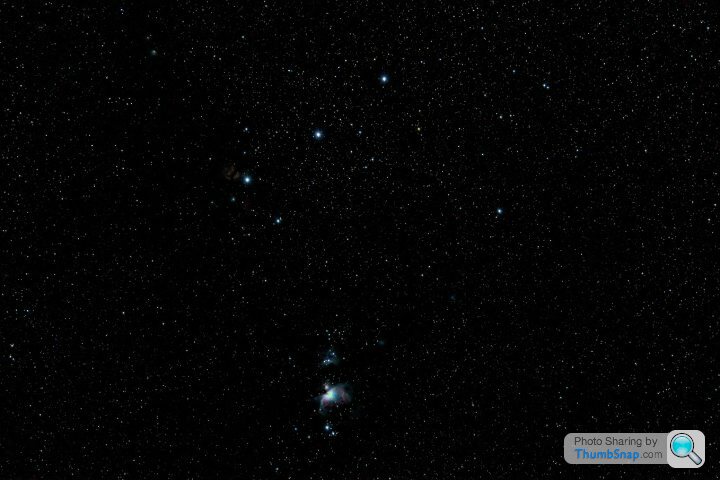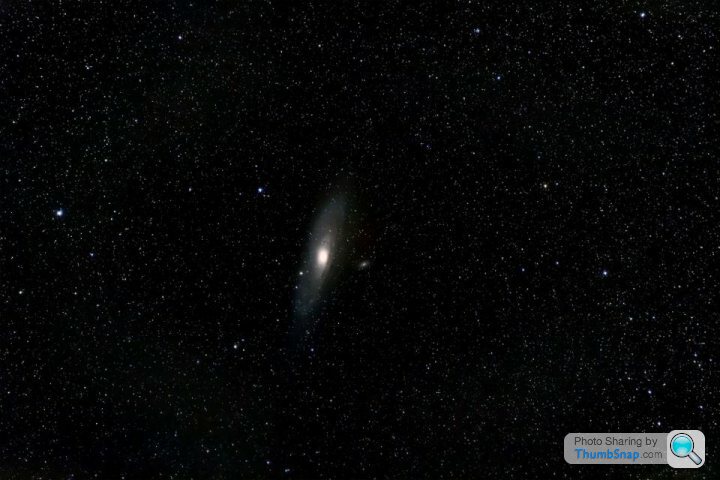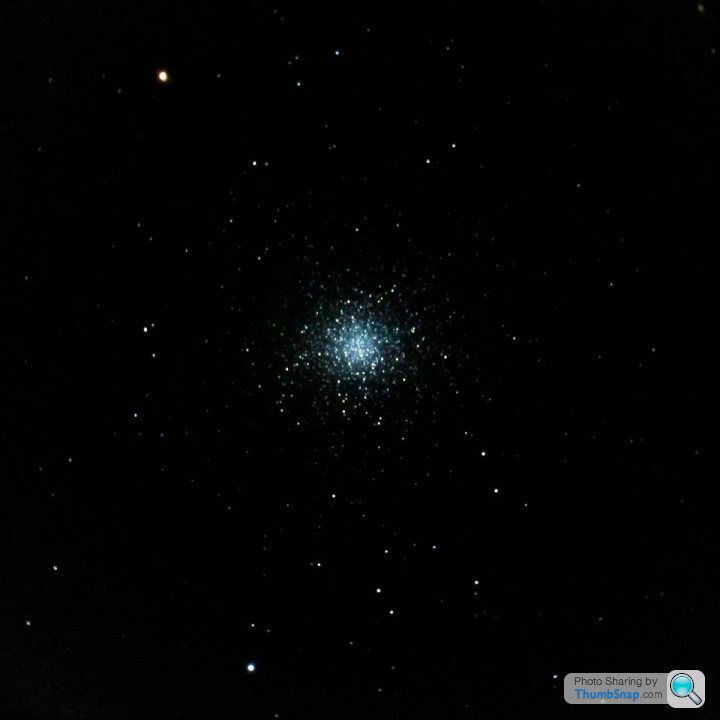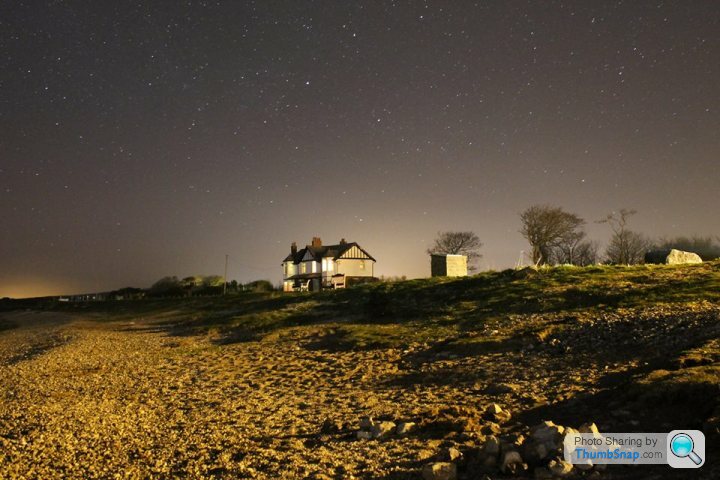Star Photography
Discussion
Gilhooligan said:
Didn't get the 'super moon' but I did venture out recently as the sky was clear. 30 sec, f4 and ISO 3200. Really need to get myself a faster lens that is relatively wide angle.
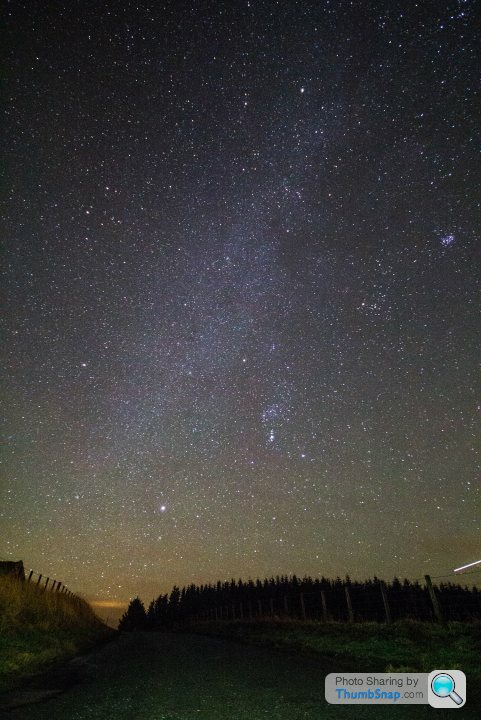
Nice. Yeah I shoot with f4 too at the moment because I had to sell my beloved Samyang. I've used my 50mm a few times. In fact, my most recent star photography effort I hadn't posted in here and that was done with 4 shots from a 50mm:

RobbieKB said:
Nice. Yeah I shoot with f4 too at the moment because I had to sell my beloved Samyang. I've used my 50mm a few times. In fact, my most recent star photography effort I hadn't posted in here and that was done with 4 shots from a 50mm:

I have a cheapo 50mm f1.8 prime. Would be good to see how any pictures come out with a bit less ISO as mines come out pretty grainy. Might have to give it a go although with the crop factor, I might not get much sky in! 
RobDickinson said:
You need to gather more light.
I tend to shoto at 10-30 seconds, ISO 3200-6400 f2-3.5
I will experiment some more when the clouds disappear. I did take a couple of test shots at 12800 but very grainy indeed. Then again I'm just grabbing the JPGs, sticking them through StarStax and leaving it, so perhaps more post is required.I tend to shoto at 10-30 seconds, ISO 3200-6400 f2-3.5
RobbieKB said:
They are great. What setup did you use? If you don't mind me asking. (Camera/lens/EXIF etc.)
From memory:Orion and the Andromeda Galaxy were taken using my 5D mk2 + 70-200L F4 piggybacked on my telescope. Andromeda was at about 170mm, whereas Orion was wider - 80mm I think. They were both comprised of multiple ~30 second subs at high iso (6400 I think), registered and stacked in deep sky stacker - then colour corrected, denoised etc in Photoshop.
The picture of M13 was taken using the 5D mk2 attached to the telescope itself (10" SCT). Can't remember the details - but the subs must have been pretty short exposures (~10 seconds) as the scope was unguided and in Alt-Az mode. Again - registered and stacked using deep sky stacker etc.
Edited by Moonhawk on Friday 20th February 11:38
Moonhawk said:
From memory:
Orion and the Andromeda Galaxy were taken using my 5D mk2 + 70-200L F4 piggybacked on my telescope. They were ~30 second subs at high iso (6400 I think) registered and stacked in deep sky stacker - then colour corrected, denoised etc in Photoshop.
Do you have a link to show an adapter that links the telescope to a lens? Never seen one before and would be great for me, as i only have a cheap telescope and cant focus closely enough /move the rear mirror forward enoughOrion and the Andromeda Galaxy were taken using my 5D mk2 + 70-200L F4 piggybacked on my telescope. They were ~30 second subs at high iso (6400 I think) registered and stacked in deep sky stacker - then colour corrected, denoised etc in Photoshop.
rj1986 said:
Do you have a link to show an adapter that links the telescope to a lens? Never seen one before and would be great for me, as i only have a cheap telescope and cant focus closely enough /move the rear mirror forward enough
To attach the camera directly to the telescope - you'll need a T-adapter and a T-ring as a minimum.The T-adapter replaces your eyepiece and the T-ring screws onto the T-adapter and has a fitting specific to your SLR/DSLR. This configuration allows for "prime focus" astrophotography.

Alternatively - instead of the T-adapter - you can get what are called "variable eyepiece projection adapters".

You'll still need a T-ring compatible with your camera - but these types of adapters allow you to vary the distance between the scope and the camera. They also allow you to insert a standard 1.25" eyepiece into the adapter to allow for eyepiece projection.
Moonhawk said:
To attach the camera directly to the telescope - you'll need a T-adapter and a T-ring as a minimum.
The T-adapter replaces your eyepiece and the T-ring screws onto the T-adapter and has a fitting specific to your SLR/DSLR. This configuration allows for "prime focus" astrophotography.

Alternatively - instead of the T-adapter - you can get what are called "variable eyepiece projection adapters".

You'll still need a T-ring compatible with your camera - but these types of adapters allow you to vary the distance between the scope and the camera. They also allow you to insert a standard 1.25" eyepiece into the adapter to allow for eyepiece projection.
Ive got one of them, and as i use a cheap scope it cant focus properly so i'll try the variable eye piece doo-dads.The T-adapter replaces your eyepiece and the T-ring screws onto the T-adapter and has a fitting specific to your SLR/DSLR. This configuration allows for "prime focus" astrophotography.

Alternatively - instead of the T-adapter - you can get what are called "variable eyepiece projection adapters".

You'll still need a T-ring compatible with your camera - but these types of adapters allow you to vary the distance between the scope and the camera. They also allow you to insert a standard 1.25" eyepiece into the adapter to allow for eyepiece projection.
Im interested how you piggyback your 70-200 to it (unless im being very thick)
Gilhooligan said:
I have a cheapo 50mm f1.8 prime. Would be good to see how any pictures come out with a bit less ISO as mines come out pretty grainy. Might have to give it a go although with the crop factor, I might not get much sky in!
Have to be careful with the cheap 50mm, usually hard to focus and have a lot of vignetting. Also on crop a very narrow field of view, and the 500 rule hits you , 5s exposures
Hi
Total newbie here. I've been reading about night-time photography for a while and, having read this thread (and many others), thought I'd have a go. I've only got a Sony SLT A37 so I'm not expecting anything special. My problem, at the moment, is getting the picture in focus. It's pitch black and I can't see enough to be able to manually focus on anything!
maccboy
Total newbie here. I've been reading about night-time photography for a while and, having read this thread (and many others), thought I'd have a go. I've only got a Sony SLT A37 so I'm not expecting anything special. My problem, at the moment, is getting the picture in focus. It's pitch black and I can't see enough to be able to manually focus on anything!
maccboy
maccboy said:
Hi
Total newbie here. I've been reading about night-time photography for a while and, having read this thread (and many others), thought I'd have a go. I've only got a Sony SLT A37 so I'm not expecting anything special. My problem, at the moment, is getting the picture in focus. It's pitch black and I can't see enough to be able to manually focus on anything!
maccboy
The general consensus seems to be put it in manual focus, and then go to infinity and back a bit, unless you have a totally manual lens in which case just going to infinity is probably fine. Total newbie here. I've been reading about night-time photography for a while and, having read this thread (and many others), thought I'd have a go. I've only got a Sony SLT A37 so I'm not expecting anything special. My problem, at the moment, is getting the picture in focus. It's pitch black and I can't see enough to be able to manually focus on anything!
maccboy
Just about the only thing I really miss about not loving in the west of Ireland anymore is the skies. Living in London is crap for stargazing.
rj1986 said:
Im interested how you piggyback your 70-200 to it (unless im being very thick)
Does your telescope have tracking? If not - there is little point piggybacking.How you piggyback will depend on the specifics of your scope and mount. Some manufacturers make camera mounts for their telescopes and there are many aftermarket gubbins for doing the same job (dovetail plates etc).
I use Tungsten as well.
Here is a really excellent guide by Mr Dickinson who is on this forum, it helped me a lot!
http://zarphag.com/2012/11/star-photography-a-guid...
Here is a really excellent guide by Mr Dickinson who is on this forum, it helped me a lot!
http://zarphag.com/2012/11/star-photography-a-guid...
maccboy said:
Hi
Total newbie here. I've been reading about night-time photography for a while and, having read this thread (and many others), thought I'd have a go. I've only got a Sony SLT A37 so I'm not expecting anything special. My problem, at the moment, is getting the picture in focus. It's pitch black and I can't see enough to be able to manually focus on anything!
maccboy
I usually focus on a bright star (Sirius, Betelgeuse etc). If you place the star in the central focus spot - the camera should pick it up and autofocus. Once focus has been achieved - switch the lens/camera back to manual focus to prevent the camera refocussing when you hit the shutter release.Total newbie here. I've been reading about night-time photography for a while and, having read this thread (and many others), thought I'd have a go. I've only got a Sony SLT A37 so I'm not expecting anything special. My problem, at the moment, is getting the picture in focus. It's pitch black and I can't see enough to be able to manually focus on anything!
maccboy
Alternatively - if the moon is visible - focus on that.
Alternatively-alternatively - focus on a distant streetlight or other bright source on the ground that is very far away. That'll get you to pretty close to infinity.
Thanks for all the help. My results are not particularly impressive - but there was some cloud around so I'm blaming that! My pictures seem too light (ISO1600, f/5.6, 18mm) but I'm comparing them to some of the amazing shots on this thread. The sky colour on some of them is absolutely amazing. If only . . .
Edited by maccboy on Saturday 21st February 17:11
Thanks for all the help. My results are not particularly impressive - but there was some cloud around so I'm blaming that! My pictures seem too light (ISO1600, f/5.6, 18mm) but I'm comparing them to some of the amazing shots on this thread. The of the sky colours on some of them are absolutely amazing. If only . . .
Gassing Station | Photography & Video | Top of Page | What's New | My Stuff




